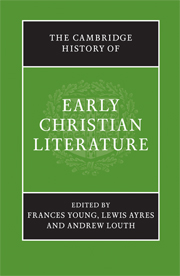Book contents
- Frontmatter
- PART ONE The Beginnings: The New Testament to Irenaeus
- A LITERARY GUIDE
- B CONTEXT AND INTERPRETATION
- 7 Social and historical setting
- 8 Articulating identity
- 9 Christian teaching
- 10 Conclusion: towards a hermeneutic of second-century texts
- PART TWO THE THIRD CENTURY
- PART THREE FOUNDATION OF A NEW CULTURE: FROM DIOCLETIAN TO CYRIL
- Bibliographies
- Index
- Map: The Roman Empire in the late fourth century AD"
- References
7 - Social and historical setting
from B - CONTEXT AND INTERPRETATION
Published online by Cambridge University Press: 28 March 2008
- Frontmatter
- PART ONE The Beginnings: The New Testament to Irenaeus
- A LITERARY GUIDE
- B CONTEXT AND INTERPRETATION
- 7 Social and historical setting
- 8 Articulating identity
- 9 Christian teaching
- 10 Conclusion: towards a hermeneutic of second-century texts
- PART TWO THE THIRD CENTURY
- PART THREE FOUNDATION OF A NEW CULTURE: FROM DIOCLETIAN TO CYRIL
- Bibliographies
- Index
- Map: The Roman Empire in the late fourth century AD"
- References
Summary
The first two centuries of the history of Christianity were crucial. It was a period of struggle for survival and the crucible in which the basic elements of Christian identity and church organization were forged. During this time, Christians had to find ways of explaining their relationship to the Jews and the broader pagan world, while suffering sporadic persecution from both, and also learn to resolve internal differences in matters of teaching, liturgy and calendar, and church organization and order. By the end of the second century, there were Christian communities scattered throughout the Empire, from Edessa in the East to Lyon in the West, displaying a remarkable diversity but also a concern to hold a common faith and pattern of life.
The early Church in Jerusalem must have initially appeared as yet another group within the remarkably variegated Judaism of the time. It was a given for Christians that what God had done in Christ must be continuous and consistent with the revelation of God in Scripture, yet it was no less clear that they were reading Scripture in a different manner. Thus while they continued to attend the Temple, the apostles also proclaimed their message from Solomon’s Portico and met in their own homes to break bread (Acts 2–3). The apostles’ preaching gathered adherents from most sections of Jewish society apart from the Sadducees. Of particular importance were the Hellenized Jews (cf. Acts 6), those Jews who preserved their religion but were otherwise culturally assimilated to their Gentile environment, and their counterparts, the Godfearers, those Gentiles attracted by the moral teaching and monotheism of the Jews but reluctant to embrace the Law fully (cf. Acts 10).
- Type
- Chapter
- Information
- The Cambridge History of Early Christian Literature , pp. 53 - 70Publisher: Cambridge University PressPrint publication year: 2004
References
- 1
- Cited by

